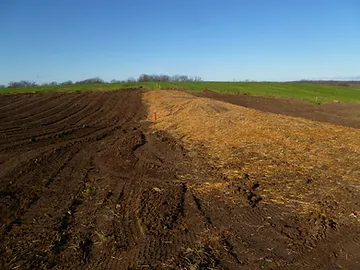Common Conservation Practices
Erosion Control:

Example of a newly constructed WASCB
-
WASCB (we say "WAHS-COB") or Water And Sediment Control Basin.
- Though it looks like just a mound of dirt, we can assure you it's much more. WASCBs are used to control gully erosion, by constructing a mound of earth across the slope of a watercourse to form a sediment trap and water retention basin. Typically built to hold a 10 year rain event, these basins are designed to drain all of that water within 24 hours.
-
Grassed Waterway
- This is eaxactly what it says, a non-cropped area, specifically designed for water to flow through erosion-free. Waterways are typically for eroison areas with large watersheds, larger than can be held in a WASCB. As opposed to holding and slowly draining water, grassed wayerways collect the storm as it comes and deposits it in the appropriate area.

Newly constructed Grassed Waterway
Soil Health & Farming:
-
Cover Crops
- Whether in the fall or spring, cover crops are a great practice for anyone interest in the health, infiltration, and retention of their soils. Used for a variety of different purposes, cover crops are a great addition to any rotation!
-
No-Till
- A practice with real benefits to the soil, hydrology, and wildlife, no-till is a sustainible farming technique all about managing residue. No-till is used to reduce energy use, build and hold organic matter, reduce sheet and rill erosion, increase infiltration, and increase biodiversity.
-
Strip-Till
- Much like No-Till, Strips till is only tilling and planting into the soil in long strips, roughly 6-10 inches apart, leaving the space in between untouched. Strip tilling can reduce erosion, improve soil health, break up compactions, improve infiltration, and improve soil warming.

Freshly tilled strips on the left, made by Jon Ransom as part of our "Planting Green" Field Day
